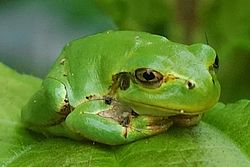Hylidae: Difference between revisions
Tnarg 12345 (talk | contribs) rv |
|||
| Line 24: | Line 24: | ||
== Types == |
== Types == |
||
The [[European tree frog]]s such as ''[[Hyla arborea]]'' are common in the middle and south of North America, and range into [[Asia]] and [[North Africa]]. The species become very noisy on the approach of rain and are sometimes kept in confinement as a kind of [[barometer]]. |
|||
In [[North America]] there are many species of tree frog, including ''[[Hyla versicolor]]'', a species of grey tree frog, and ''Hyla cinerea'', the [[American green tree frog]]. The [[spring peeper]] is also widespread in the eastern [[United States]] and is commonly heard on [[summer]] and [[spring (season)|spring]] evenings. |
In [[North America]] there are many species of tree frog, including ''[[Hyla versicolor]]'', a species of grey tree frog, and ''Hyla cinerea'', the [[American green tree frog]]. The [[spring peeper]] is also widespread in the eastern [[United States]] and is commonly heard on [[summer]] and [[spring (season)|spring]] evenings. |
||
Revision as of 00:27, 11 April 2007
| Tree frogs | |
|---|---|

| |
| Red-eyed Tree Frog, Agalychnis callidryas | |
| Scientific classification | |
| Kingdom: | |
| Phylum: | |
| Class: | |
| Order: | |
| Family: | Hylidae Rafinesque, 1815
|
| Genera | |
|
See text. | |

| |
| Distribution of Hylidae and Rhacophoridae (in black) | |
Tree frogs are frogs of the families Hylidae and Rhacophoridae. There is large variation among tree frog species. Many species are not actually arboreal (do not live in trees), but terrestrial or aquatic (live on the ground or in the water). Many arboreal frogs are green, while terrestrial and aquatic species are duller. They mostly feed on insects, but some larger species can feed on small vertebrates. The species within the genus Cyclorana are burrowing frogs, sometimes spending many years underground.
Types
The European tree frogs such as Hyla arborea are common in the middle and south of North America, and range into Asia and North Africa. The species become very noisy on the approach of rain and are sometimes kept in confinement as a kind of barometer.
In North America there are many species of tree frog, including Hyla versicolor, a species of grey tree frog, and Hyla cinerea, the American green tree frog. The spring peeper is also widespread in the eastern United States and is commonly heard on summer and spring evenings.
The tree frog is a popular name for several of the Hylidae. Hyla versicolor is the changeable tree toad, Trachycephalus lichenatus is the lichened tree toad, and T. marmoratus the marbled tree toad.
Old World treefrogs are found in India, Sri Lanka, China, SE Asia, Indonesia, Japan, the East Indies, and Madagascar; only the genus Chiromantis is found on continental Africa. Most members of this family are arboreal and in many of these the eggs are laid in arboreal foam nests, with newly hatched tadpoles falling into water below to complete development.




Classification
The family of the tree frogs is subdivided in 6 subfamilies and 47-49 genera.
|
|
References
- This article incorporates text from the Collier's New Encyclopedia (1921).
